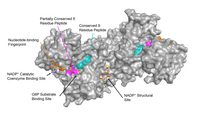
Photo from wikipedia
Recent studies indicate that 4-hydroxy-trans-2-nonenal (HNE), a major oxidative stress triggered lipid peroxidation-derived aldehyde, plays a critical role in the pathophysiology of various human pathologies including metabolic syndrome, diabetes, cardiovascular,… Click to show full abstract
Recent studies indicate that 4-hydroxy-trans-2-nonenal (HNE), a major oxidative stress triggered lipid peroxidation-derived aldehyde, plays a critical role in the pathophysiology of various human pathologies including metabolic syndrome, diabetes, cardiovascular, neurological, immunological, and age-related diseases and various types of cancer. HNE is the most abundant and toxic α, β-unsaturated aldehyde formed during the peroxidation of polyunsaturated fatty acids in a series of free radical-mediated reactions. The presence of an aldehyde group at C1, a double bond between C2 and C3 and a hydroxyl group at C4 makes HNE a highly reactive molecule. These strong reactive electrophilic groups favor the formation of HNE adducts with cellular macromolecules such as proteins and nucleic acids leading to the regulation of various cell signaling pathways and processes involved in cell proliferation, differentiation, and apoptosis. Many studies suggest that the cell-specific intracellular concentrations of HNE dictate the anti-oxidative and pro-inflammatory activities of this important molecule. In this review, we focused on how HNE could alter multiple anti-oxidative defense pathways and pro-inflammatory cytotoxic pathways by interacting with various cell-signaling intermediates.
Journal Title: Oxidative Medicine and Cellular Longevity
Year Published: 2019
Link to full text (if available)
Share on Social Media: Sign Up to like & get
recommendations!